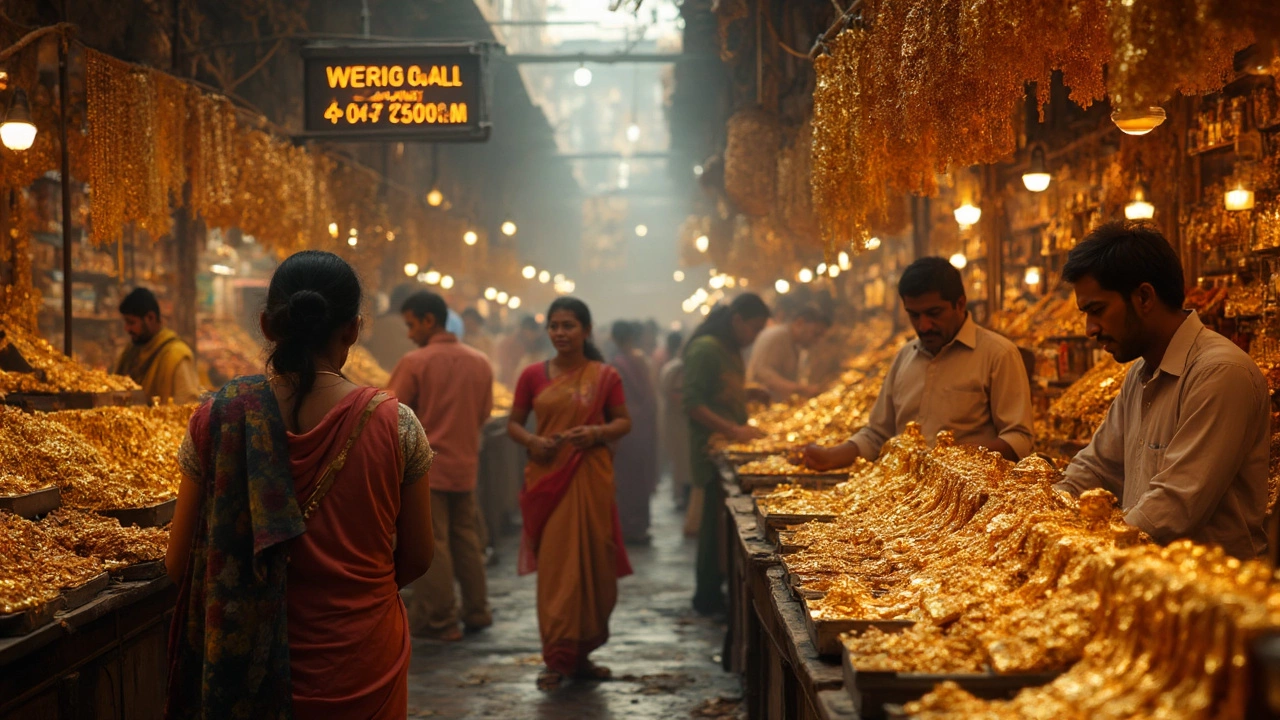People hear wild numbers tossed around for gold and start thinking, “Could it really hit $5,000 an ounce?” That price tag sounds like fantasy—until you remember, a decade ago, folks said the same thing about $2,000 or $3,000. Gold has a habit of surprising everyone.
If you’re living in India, gold isn’t just “an investment.” It’s something you might keep for family, for emergencies, or even for a loan. Gold loans here are a lifeline for many, since banks and lenders trust gold more than any salary slip. So, gold’s price matters to regular people, not just rich investors or banks in Mumbai.
The big numbers get headlines, but what actually makes gold jump so high—or crash out of nowhere? It’s not all about global politics or wars. Sometimes it’s currency changes, local demand, even wedding season. If you’re thinking about using your gold as collateral for a loan, or just trying to decide if now’s the time to buy or sell, you’ve got to look beyond the hype.
- Why the Buzz Around $5,000 an Ounce?
- What Drives Gold Prices Up (or Down)?
- Gold Loans in India: What High Prices Mean
- Tips for Everyday Investors
Why the Buzz Around $5,000 an Ounce?
The talk about gold heading to $5,000 an ounce picked up steam when things started getting shaky in the global economy. Big banks and financial gurus have tossed around this number every time the world looks tricky—like during the COVID-19 pandemic and again when inflation surged in 2023 and 2024.
Back in August 2020, gold actually broke above $2,000 an ounce for the first time ever. That shocked a lot of seasoned investors and got regular folks watching the price more closely. Every time gold sets a new all-time high, someone predicts an even crazier number for the future.
Why does this $5,000 figure get so much attention? For one, gold is seen as a "safe haven"—when markets fall, people park their money in gold, hoping it holds its value. Also, central banks in countries like India and China have been buying up gold like there’s no tomorrow. In 2023, central banks purchased over 1,000 tonnes of gold, setting a record.
Media headlines play a part, too. If a famous investor—someone like Ray Dalio—says gold could go to $5,000, it spreads fast. Regular people see those headlines and wonder if they should hurry up and buy or if they’re already too late.
But here’s the thing: even if gold jumps to these levels, it’s not always because of more demand. Sometimes it’s just the gold price keeping up with inflation or the rupee getting weaker against the dollar. The buzz isn’t just hype—it’s a mix of real worries, big purchases by countries, and the way news travels these days.
What Drives Gold Prices Up (or Down)?
Gold doesn’t just float to new highs on a whim. A handful of things—sometimes pretty boring, honestly—are behind those wild numbers you see on the news. The most obvious one is demand. If more people in India, China, or anywhere else want to buy gold for weddings, saving, or just showing off, the price goes up. Flip side? If people start selling en masse, prices fall.
The next big thing is inflation. When money loses value—even a little—people freak out and park their cash in gold. It’s like a safety net. Central banks buying gold can also push prices up. In 2023, when the Reserve Bank of India and some others added tons of the stuff to their reserves, prices spiked globally. But if they decide to sell instead, you get the opposite effect.
Then there’s the U.S. dollar—yep, something happening in America messes with gold in India. Gold is priced worldwide in dollars. If the dollar weakens, gold looks cheaper to folks outside the U.S., so they buy more, and up goes the price. If the dollar gets stronger, people pull back.
Remember those headlines about war or global drama? That shakes up everyone’s nerves and makes gold popular again. It’s what people reach for when nothing else feels safe, like during Russia-Ukraine news spikes or the pandemic’s darkest weeks.
Let’s break it down:
- Local gold demand and festival season can push gold higher in India even if prices are flat elsewhere.
- Central banks buying or selling makes waves across countries.
- Currency rates, especially the U.S. dollar, can make gold jump or dip overnight.
- Big political or economic shocks—like wars or recessions—boost gold as a ‘safe’ investment.
For anyone considering a gold price prediction, these drivers matter way more than rumors. Just remember, what happens outside your city or even your country can hit your gold’s value here very quickly.

Gold Loans in India: What High Prices Mean
When gold prices go up, everyone holding gold at home suddenly feels a bit richer. For a lot of families in India, gold is almost like a savings account you wear or store in a drawer. But the real twist comes when you need some quick cash. That’s where gold loans step in, and a spike in gold prices changes the whole game.
Here’s how it works: the value of your jewelry or coins decides how much money you can borrow from the bank or a gold loan company. The higher the gold price per gram, the bigger the loan you can get on the same bangle or chain. So, if gold price pushes toward $5,000 an ounce, folks in India could borrow nearly double what they could just a few years ago, using the same stash of gold.
What’s the catch? Loan-to-value ratios are set by RBI (Reserve Bank of India). Right now, lenders can go up to 75% of your gold’s value. So if your gold is suddenly worth more because of global price hikes, your loan eligibility jumps. But remember, gold loans are short-term. If you can’t pay back, the lender can auction your gold—which stings, especially when prices are high.
Some practical tips if you’re eyeing a gold loan during a price surge:
- Shop around—different banks and NBFCs (non-banking finance companies) offer different interest rates and fees.
- Always check the purity and weight details written down by the lender. Mistakes or under-valuing can mean less in your pocket.
- Don’t get carried away by high gold prices. Only borrow what you really need and can manage to repay fast.
If gold hits some wild number like $5,000, you can expect lenders to push a lot more marketing, hoping folks will walk in and pawn their family jewelry. Good for emergencies, but don’t forget: the gold stays with the lender till you pay back, and missing payments during sky-high prices could mean losing out big.
Tips for Everyday Investors
If you’re looking at your gold chain and wondering if it’s your ticket to making big money, a few things matter more than rumors. Forget the hype from YouTube or what neighbors say about gold reaching new highs overnight. Here’s what everyday folks in India should keep in mind if they’re thinking about buying, holding, or taking a gold loan when the price keeps making the news.
- Gold price moves for many reasons, not just international news, but the rupee’s value, local demand, import taxes, and government rules. Even something like festival season (like Akshaya Tritiya or Diwali) tends to push prices up in India.
- Don’t wait for some magic number like $5,000 an ounce. Nobody has a crystal ball. Instead, watch the main drivers week to week—like global market shocks, central bank decisions, or inflation reports.
- If you’re considering a gold loan, know how lenders work. Most banks in India only lend 75% of your gold’s value, as per RBI guidelines. So, if gold prices go up, you could get a higher loan for the same jewelry.
- Avoid putting all your savings into gold. Experts say it’s safer to keep just 10-15% of your investment in gold, not more—even when things look promising. Mix with stocks, mutual funds, or fixed deposits for safety.
- Remember, making money from gold isn’t just about selling. You can often get quick funds through a gold loan without selling off family assets. Just check for extra fees, processing charges, and interest rates before handing your jewelry to any lender.
| Year | Avg. Gold Price (INR/10g) | Gold Loan Interest Rates | Loan-to-Value Limit |
|---|---|---|---|
| 2022 | 51,000 | 7% - 12% | 75% |
| 2023 | 55,000 | 8% - 13% | 75% |
| 2024 | 67,000 | 10% - 16% | 75% |
If you really care about picking the right moment, keep an eye on trends rather than predictions. No one can reliably say when—or if—gold will reach that magic number. Staying practical and spreading your risk is a smarter play. And if you end up sitting at the gold shop with your spouse, like I did with Amelia, focus on what fits your needs right now—not just what some headline says.


